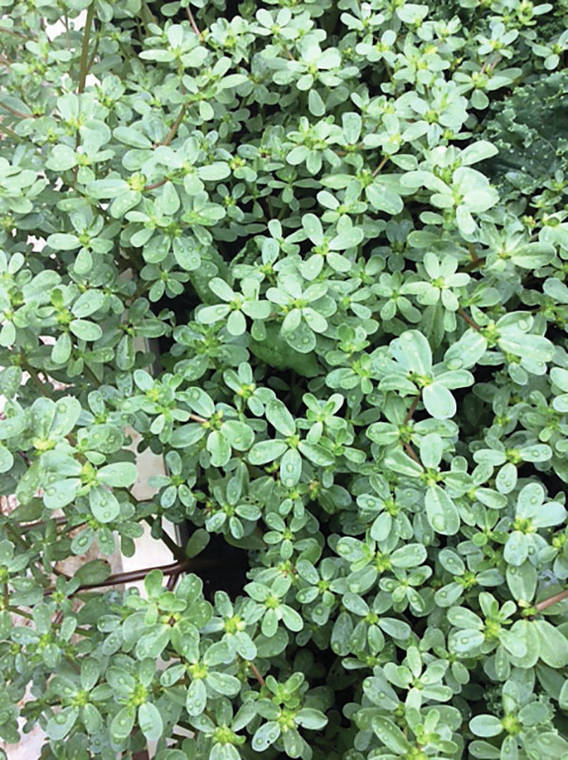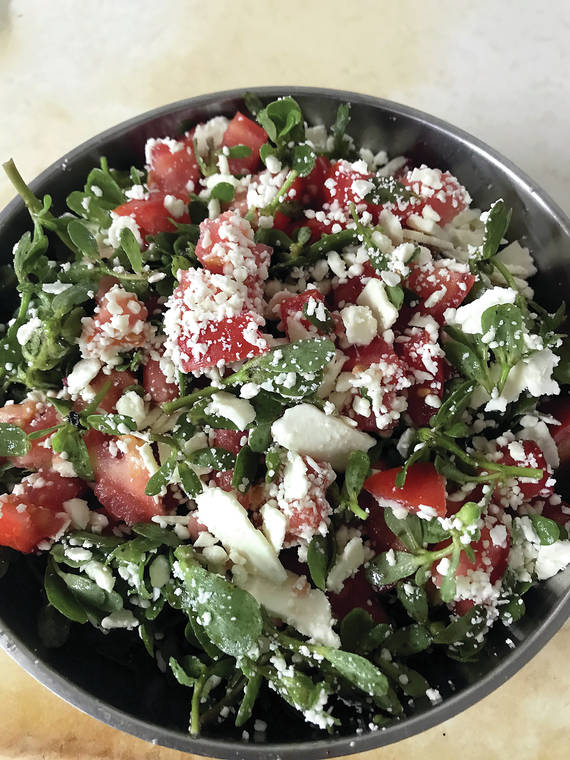Back in 1993, organic farming was a novelty, but Family Farm, Inc., owned and operated by Chris Yuen and Noelie Rodriguez, was determined to be totally organic and natural. With the use of manure and natural plants that repel insects, they are a successful and viable organic farm today. No pesticides or chemical fertilizers are used to grow bananas, lychee, rambutans, moringa, ginger, turmeric, pipinola, poha berries, jaboticabas, beans, herbs, onions, and purslane.
Although purslane is considered a weed, it is a highly nutritious vegetable, loaded with omega-3 fatty acids. Scientifically known as Portulaca oleracea, it is also known as pigweed, little hogweed, fatweed, and pusley.
It tastes like spinach and watercress, with a slight sour or salty taste. It is good in salads, in tacos, or can be cooked.
Purslane originally came from India and Iran and now is found around the world in a wide range of environments. It can also adapt to harsher conditions like drought or nutrient-deficient soil. That is probably why when we think of purslane we often think of a weed growing in sidewalk cracks.
Purslane has been used as a traditional and alternative medicine. It is used to treat burns, headaches, stomachaches, coughs, arthritis, just to name a few.
According to Healthline, “Purslane is high in omega-3 fatty acids. Omega-3 fatty acids are important fats that the body cannot produce.
While purslane is low in total fat, a large portion of the fat it does contain is in the form of omega-3 fatty acids.
In fact, it contains two types of omega-3 fatty acids, ALA and EPA. ALA is found in many plants, but EPA is found mostly in animal products (like fatty fish) and algae.
Compared to other greens, it is exceptionally high in ALA. It contains 5-7 times more ALA than in spinach.
Interestingly, it also contains trace amounts of EPA. This omega-fat is more active in the body than ALA, and is generally not found in plants that grow on land.”
Purslane contains bone-building nutrients such as iron, calcium, magnesium, and manganese to help prevent osteoporosis.
Rich in iron and copper, purslane can help boost our body’s circulation and stimulate the production of red blood cells.
According to Andrew Weil, M.D., purslane, besides the omega-3 fatty acids, is a natural source of melatonin, has seven times the beta-carotene of carrots and six times more vitamin E than spinach.
The only downside of purslane, according to Weil, is the naturally occurring oxalate, also found in spinach, chard, beet greens and rhubarb. Oxalates are a problem for folks with kidney stones.
In Mexico, purslane is added to omelets, in the Mediterranean, it is added in soups and salads. Purslane can be cooked like spinach but becomes slimy if overcooked.
Noelie shared her recipe for chimichurri.
Noelie’s Purslane and Parsley Chimichurri
2 cups round chopped purslane
1 cup chopped Italian parsley or cilantro
1 tablespoon chopped fresh oregano or 1 teaspoon dry oregano
3 or 4 cloves garlic minced
1 teaspoon crushed red pepper flakes or any hot sauce you like to your taste
1/2 cup olive oil
2 tablespoon balsamic or red wine vinegar
Salt and pepper to taste.
Remove bitter stems from purslane. Gather all ingredients and run them through a food processor until smooth. Use as marinade or accompaniment to beef.
• • •
Here’s a couple of salads using purslane:
Cucumber Purslane Yogurt Salad
2 cucumbers, cut into quarter-round slices
1/4 pound purslane, large stems removed, washed and drained will then roughly chopped
2 tablespoons freshly chopped mint
2 tablespoons freshly chopped cilantro
2 tablespoons freshly chopped chervil
3 cups Greek yogurt
1/4 cup extra virgin olive oil
2 cloves garlic, pressed or pureed
2 teaspoons ground coriander
Salt and pepper to taste
Place the cucumber, purslane and herbs into a large bowl. In another bowl, stir together the yogurt, olive oil, garlic, coriander and season to taste with salt. Add the yogurt mixture to the vegetables and mix well. Add a pinch of ground black pepper. Taste the dressed cucumber purslane salad seasoning, adding a little more salt if needed. Served chilled.
Purslane Salad
Serves 4
3 cups roughly chopped purslane, discard thick tough stems
1 tomato, cored and roughly chopped
1/2 small red onion, thinly sliced
2-3 tablespoons red wine vinegar
1 tablespoon extra-virgin olive oil
Salt and pepper to taste
1/4 cup feta cheese, cut or crumbled into bite-sized pieces
Add the purslane, tomato, onion, 2 tablespoons vinegar, and olive oil to a bowl, stir gently to combine.
Add salt and pepper to taste, and add more vinegar, if desired.
Top with crumbled feta.
Foodie bites
Family Farms, Inc. sells bags of purslane to Island Naturals, if you want to try this superfood.



